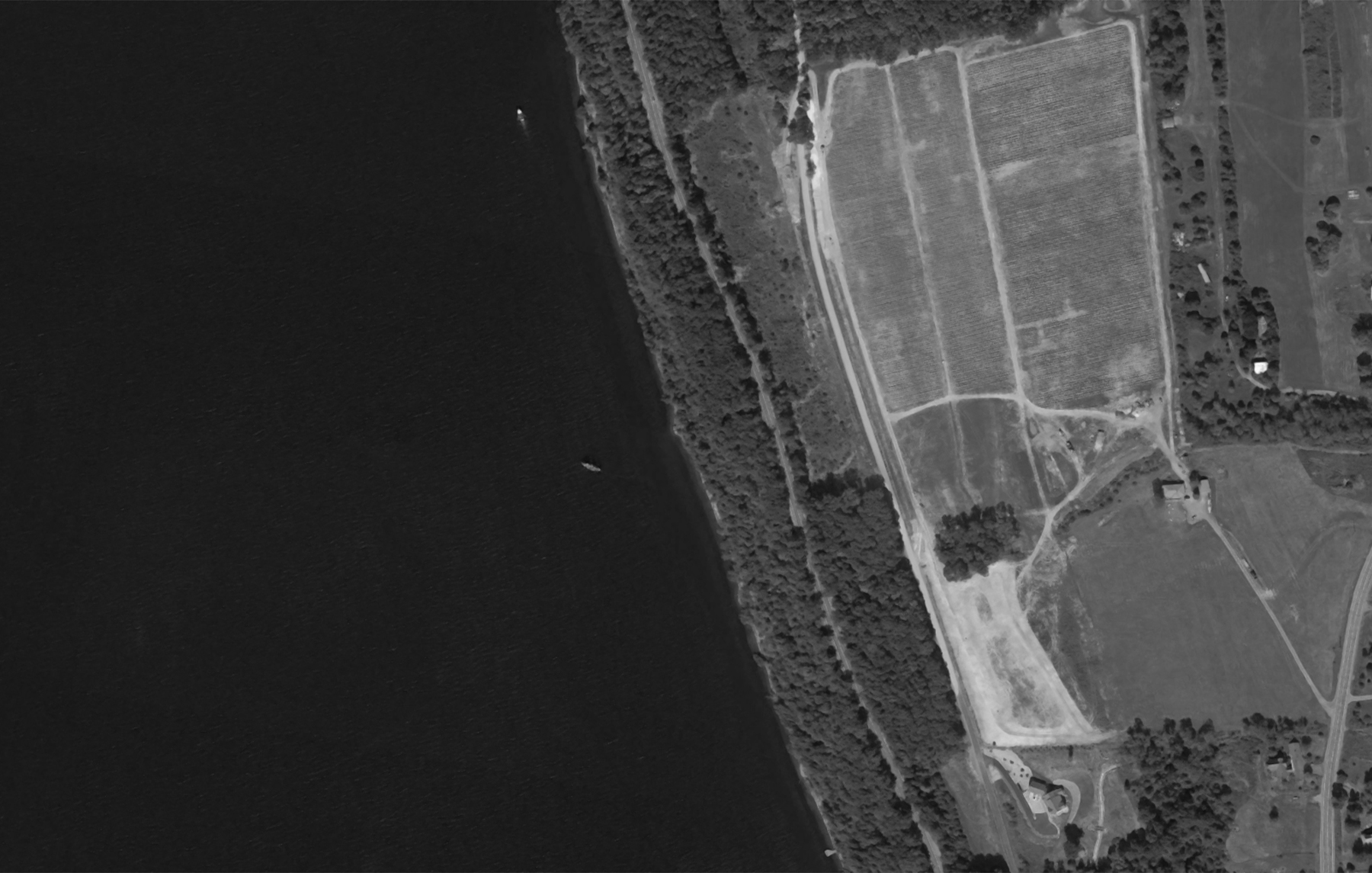
Seneca Lake
Carved out of glacial movement that began during the Ice Age over two million years ago, the Finger Lakes is the result of ice sheets that last receded and melted approximately 10,000 years ago. Seneca Lake is the deepest (618’ deep below sea level) and one of the two largest in length next to Cayuga Lake.
VINEYARD INFO
Plant Dates 2014, 2015, 2017, 2018, 2019
Planted Acres 21 (78 total, potential for up to 47 planted acres)
Total planted blocks 4 (blk acres: a – 10; b – 5; c – 5; e – 1)
Vines per acre 1,815 / Spacing 6x4
Rootstocks 3309, so4, Riparia Gloire (rg), Selection Oppenheim (so4), 101-14
Variety & Clonal Selection Riesling (198, 239, 90, 110, HJW (Hermann J. Wiemer), 22.1)
VINEYARD INFO
60% blue slate from Mesozoic time period
25% glacial till Characterized as boulders and pebble rock by the Ice Age
15% limestone glacial shale Found sporadically, created from Mesozoic time period up to present day
Seneca Lake
We are vigilant in our stewardship of the land and engaged in labor-intensive, hand-farming methods year-round to grow fruit to the highest quality. The up to 55-degree gradient requires specialized equipment and erosion prevention measures such as no tilling or exposed soils and year-round cover crop.
Read More
Seneca Lake
After years of searching around the Finger Lakes, Paul and David ultimately concentrated their efforts on Seneca Lake and found a property with similar attributes to those found in the famed Mosel region. Previously planted to native Labrusca varieties in the late 1800’s, the property started to become overgrown in the 1930’s after farming was abandoned. Old cedar posts and wire trellising were found in the wooded areas, along with small terraces that allowed horses to work the original vineyard.
Seneca Lake
Carved out of glacial movement that began during the Ice Age over two million years ago, the Finger Lakes is the result of ice sheets that last receded and melted approximately 10,000 years ago. Seneca Lake is the deepest (~618’ deep) and one of the two largest in length next to Cayuga Lake.
Seneca Lake
Carved out of glacial movement that began during the Ice Age over two million years ago, the Finger Lakes is the result of ice sheets that last receded and melted approximately 10,000 years ago. Seneca Lake is the deepest (~618’ deep) and one of the two largest in length next to Cayuga Lake.
The region’s microclimate is greatly influenced by the moderating effects from this body of water and where Riesling can thrive. In spring, the deep water creates cold air, which is carried off the lake to help delay bud break and lower the risks of frosts. As the lake increases in temperature over the summer months, the warm air filtrates up-slope late through the growing season into the fall.
Our steep slopes in concert with the airflow created from the lake enhances sustainable farming. At night, air drains down-slope towards the lake, and in the morning, airflows up-slope, dispersing any fog that may occur and helping canopies dry out faster.
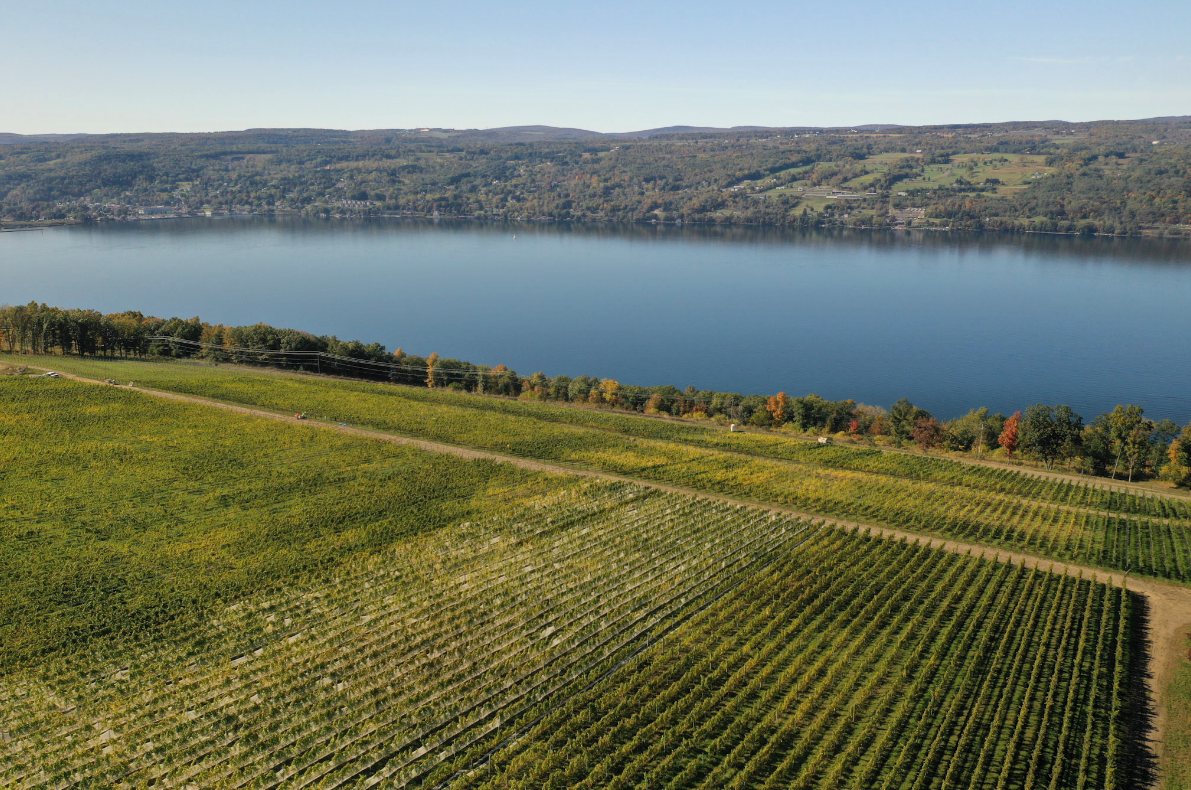
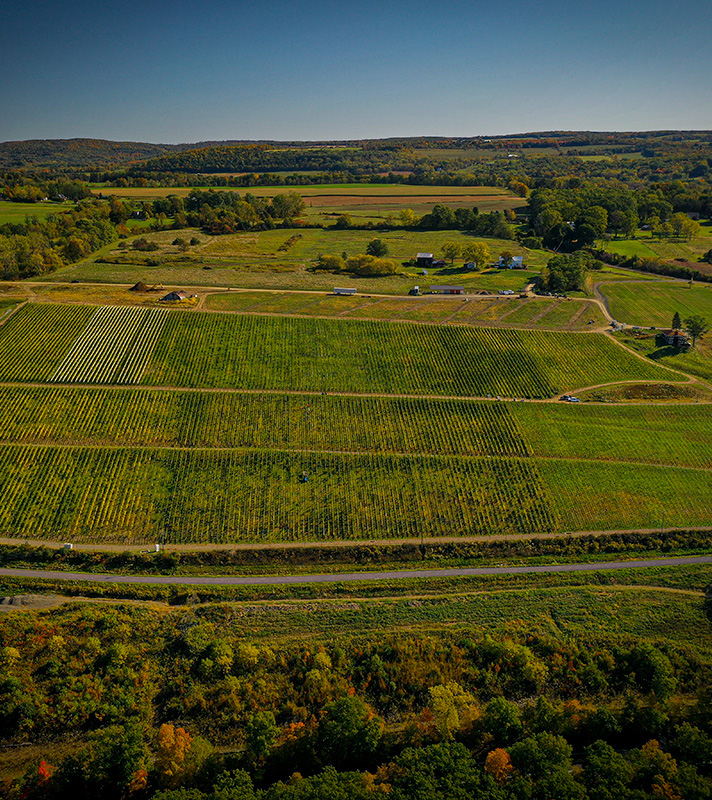
Estate
Situated on the southeastern banks of Seneca Lake, the property was acquired in 2013 and started being converted to Riesling one year later. The vineyards are planted to high density and one of the first in the area to run up and down slope similar to those of the Mosel region.
Estate
Situated on the southeastern banks of Seneca Lake, the property was acquired in 2013 and started being converted to riesling one year later. The vineyards are planted to high density and one of the first in the area to run up and down slope similar to those of the Mosel region.
Slopes are 10-55 degrees at an elevation up to 880 feet above sea level. The western exposure on these steep slopes allows for both sides of the canopy to optimize the sun exposure and airflow, which facilitates earlier ripening, vine and cluster health.
There are also two ravines are located on the property – one to the north and one in the middle of our estate – which is created by groundwater and runoff moving towards Seneca Lake. They are deeper than the convexed-shaped vineyard floor, helping cold air descend into the deep ravines and warm air move into the canopy. This has a substantial effect on mitigating frosts while also contributing to sustainability and quality of fruit.
Discovery & Development
After years of searching around the Finger Lakes, Paul and David ultimately concentrated their efforts on Seneca Lake and found a property with similar attributes to those found in the famed Mosel region. Previously planted to native Labrusca varieties in the late 1800’s, the property started to become overgrown in the 1930’s after farming was abandoned. Old cedar posts and wire trellising were found in the wooded areas, along with small terraces that allowed horses to work the original vineyard.
Discovery & Development
After years of searching around the Finger Lakes, Paul and David ultimately concentrated their efforts on Seneca Lake and found a property with similar attributes to those found in the famed Mosel region. Previously planted to native Labrusca varieties in the late 1800’s, the property started to become overgrown in the 1930’s after farming was abandoned. Old cedar posts and wire trellising were found in the wooded areas, along with small terraces that allowed horses to work the original vineyard.
The process of reclaiming the land back to vineyards began in 2013 and was a massive undertaking that required ingenuity and grit over nearly a decade. Before development could commence, innovative solutions unconventional by industry standards were necessary. The team engaged in a SWPPP (storm water prevention pollution program) and installed proper drainage channels on the site’s steep slopes to conserve the land’s attributes as well as minimize any environmental impact to Seneca Lake.
Once the site was ready for high-density plantings, holes for new grapevines had to be punched into the ground, one by one, using a custom-built jackhammer and trellised by hand.
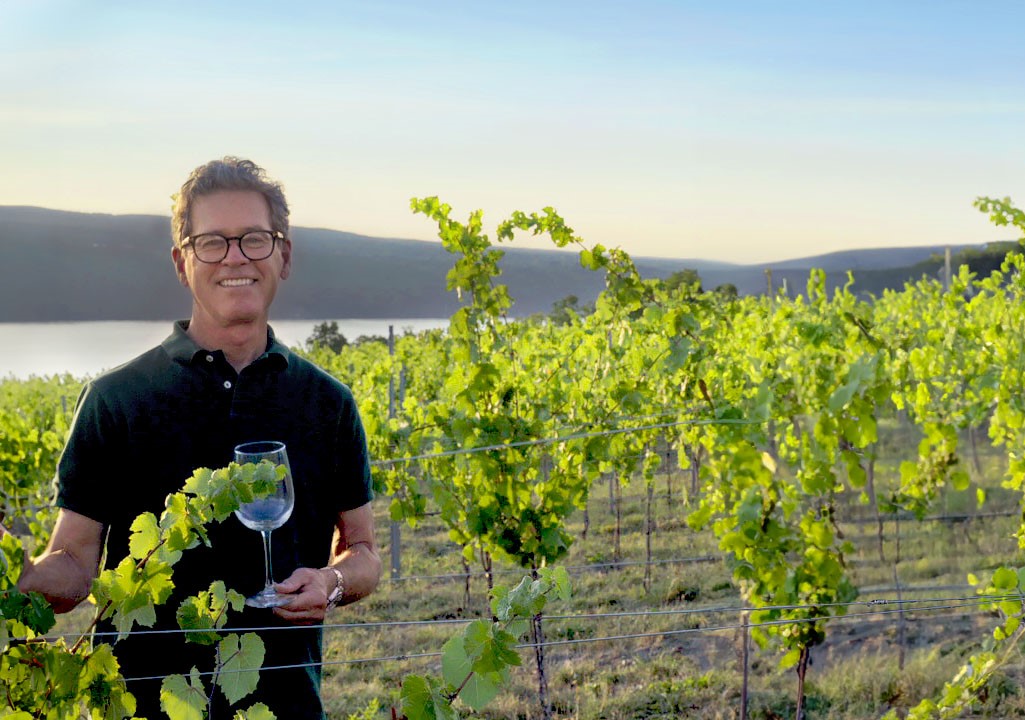
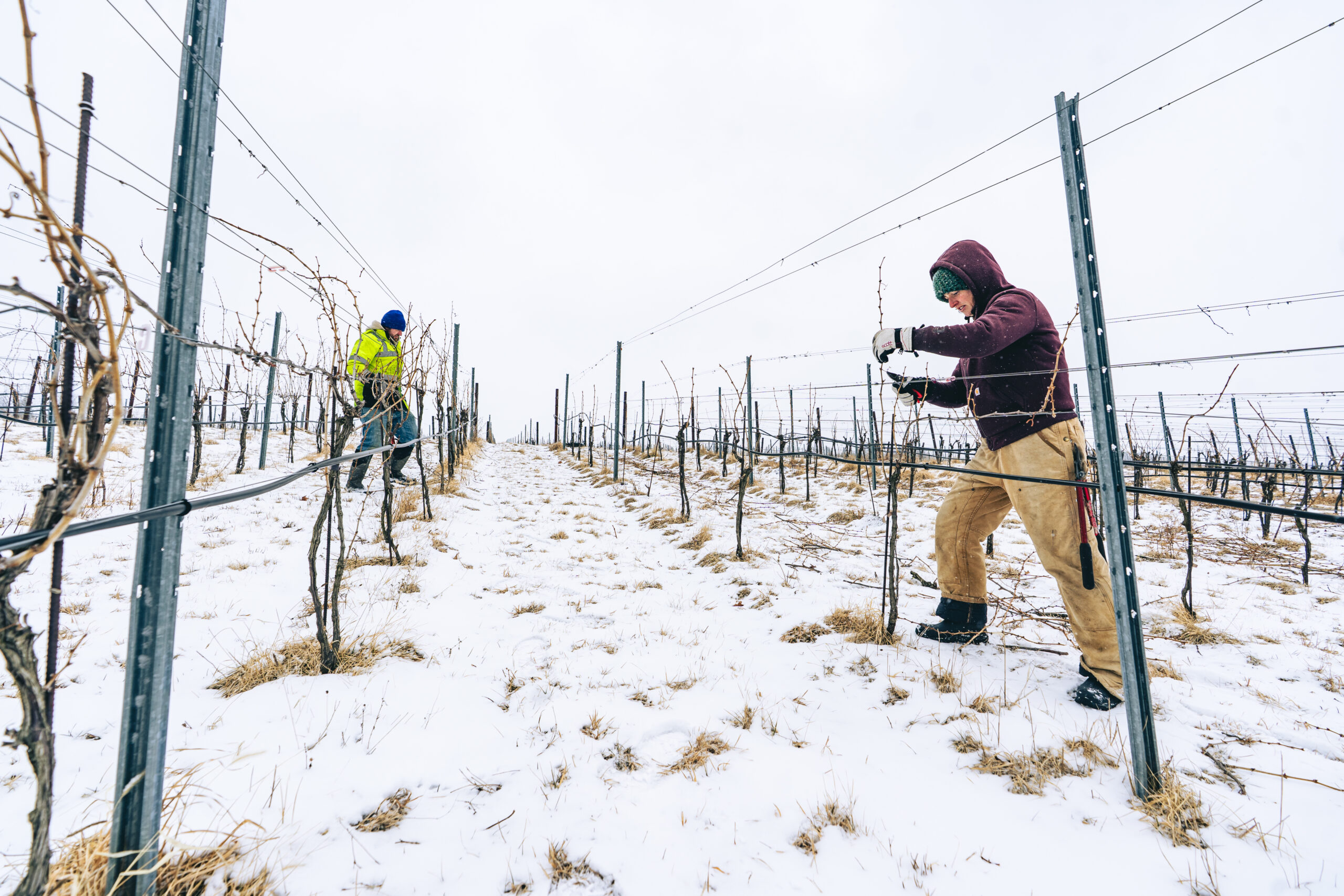
Farming
We are vigilant in our stewardship of the land and engaged in labor-intensive, hand-farming methods year-round to grow fruit to the highest quality. The up to 55-degree gradient requires specialized equipment and erosion prevention measures such as no tilling or exposed soils and year-round cover crop.
Hillick & Hobbs Estate is certified under New York Sustainable Winegrowing.
Farming
After years of searching around the Finger Lakes, Paul and David ultimately concentrated their efforts on Seneca Lake and found a property with similar attributes to those found in the famed Mosel region. Previously planted to native Labrusca varieties in the late 1800’s, the property started to become overgrown in the 1930’s after farming was abandoned. Old cedar posts and wire trellising were found in the wooded areas, along with small terraces that allowed horses to work the original vineyard.
The process of reclaiming the land back to vineyards began in 2013 and was a massive undertaking that required ingenuity and grit over nearly a decade. Before development could commence, innovative solutions unconventional by industry standards were necessary. The team engaged in a SWPPP (storm water prevention pollution program) and installed proper drainage channels on the site’s steep slopes to conserve the land’s attributes as well as minimize any environmental impact to Seneca Lake.
Once the site was ready for high-density plantings, holes for new grapevines had to be punched into the ground, one by one, using a custom-built jackhammer and trellised by hand.
The estate revives the Hobbs family legacy of growing grapevines in upstate New York.

